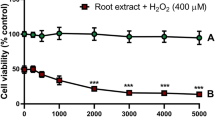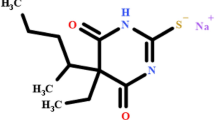Abstract
IT is well known that enterochromaffin cells acquire a golden-yellow fluorescence after fixation in formaldehyde, due probably to their content of enteramine (5-hydroxytryptamine). We have now carried out chromatographic experiments with synthetic 5-hydroxytryptamine creatinine phosphate to study the sensitivity and specificity of this reaction. We used a butanol – acetic acid – water solvent and a developer composed of nine parts of a solution of potassium dichromate (0.1 per cent) and one part of formaldehyde solution (37–41 par cent). After spraying and heating at 100–110° C. for five minutes, the paper is viewed under ultra-violet light. Under these conditions, 5-hydroxytryptamine (RF value 0.38) produces a golden-yellow fluorescence immediately after the heating and this persists for days; quantities as small as 0.2 µgm. base can be detected. The behaviour of bufotenine and bufotenidine is quite similar to that of 5-hydroxytryptamine. Tryptamine gives a bright yellow fluorescence if more than 2.5 µgm, are present; but this develops slowly. Tryptophane likewise gives a yellowish fluorescence if 2.5 µgm. are present, while 5-methoxytryptamine gives a yellow-orange fluorescence if similar amounts are present. Bufothionine, histamine, histidine, tyramine, tyrosine and p-norsynephrine produce no fluorescence, while that with adrenaline and nor-adrenaline is very feeble. m-Norsynephrine has already been shown to produce a violet fluorescence under these conditions if 0.5 µgm. is present1. Such a small amount of 5-hydroxytryptamine (0.2µgm.) can also be detected with alkaline Folin reagent (producing a blue colour), Pauly reagent (red), diazotized p-nitraniline reagent (red-brown), N.N.C.D. reagent of Heinrich and Schuler (red-brown), Gibbs reagent (brownish-violet) and Ehrlich's reagent (blue)2.
This is a preview of subscription content, access via your institution
Access options
Subscribe to this journal
Receive 51 print issues and online access
$199.00 per year
only $3.90 per issue
Buy this article
- Purchase on SpringerLink
- Instant access to full article PDF
Prices may be subject to local taxes which are calculated during checkout
Similar content being viewed by others
References
Shepherd, D. M., and West, G. B., Nature [171, 1160 (1953)].
Erspamer, V., and Boretti, G., Arch. int. Pharmacodyn., 88, 296 (1951).
Author information
Authors and Affiliations
Rights and permissions
About this article
Cite this article
SHEPHERD, D., WEST, G. & ERSPAMER, V. Detection of 5-Hydroxytryptamine by Paper Chromatography. Nature 172, 357 (1953). https://doi.org/10.1038/172357a0
Issue date:
DOI: https://doi.org/10.1038/172357a0
This article is cited by
-
A melanocyte-stimulating substance in the skin secretion of Xenopus laevis
Zeitschrift f�r Vergleichende Physiologie (1961)
-
Serotonin, a Melanocyte-stimulating Component in the Dorsal Skin Secretion of Xenopus laevis
Nature (1960)
-
Modellversuche zur Histochemie silberreduzierender Substrate
Virchows Archiv f�r Pathologische Anatomie und Physiologie und f�r Klinische Medizin (1959)
-
�ber die Morphologie und Histochemie der basalgek�rnten Zellen
Acta Neurovegetativa (1957)
-
On the nature of some smooth muscle active substances from the platelets
Experientia (1954)



